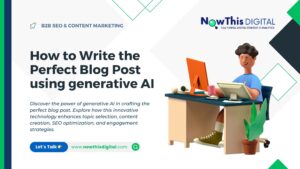AI Text Generator – What is AI Text Generation?
Generative AI in Text Generation stands as a testament to the remarkable advancements in artificial intelligence, particularly within the realm of natural language processing. Over the past few years, this technology has burgeoned into a powerful tool, pushing the boundaries of what machines can accomplish in terms of creative and coherent textual output. At its core, generative AI involves the utilization of algorithms to autonomously produce text that mirrors human-like linguistic patterns and structures. The driving force behind this innovation is models like GPT-3 (Generative Pre-trained Transformer 3), which, with its colossal neural network, is capable of comprehending and generating contextually relevant text across a myriad of subjects.
The essence of generative AI text generation lies in its ability to learn from vast datasets, absorbing the intricacies of language, context, and semantics. Pre-training on a diverse range of sources empowers these models to understand syntax, grammar, and even nuances of expression. This extensive knowledge is then harnessed during the fine-tuning phase, where the model can be specialized for specific tasks or domains. This duality allows generative AI models to be versatile, making them applicable in various fields such as content creation, virtual assistants, code generation, and more.
One of the most noteworthy aspects of generative AI in Text Generation is its potential to revolutionize content creation. With the ability to emulate different writing styles, tones, and even specific authors, these models can assist writers in producing a diverse array of content. Whether it’s generating marketing copy, drafting articles, or crafting engaging narratives, generative AI can act as a valuable co-creator, offering inspiration and augmenting the creative process. This not only enhances efficiency but also opens up new avenues for experimentation and innovation in the world of literature and journalism.
Virtual assistants powered by Generative AI in Text Generation have become increasingly sophisticated, enabling more natural and context-aware interactions. These systems can now comprehend user queries with a higher degree of nuance, providing more relevant and coherent responses. This evolution in virtual assistants has tangible implications for sectors like customer service, where AI-driven chatbots can engage in meaningful conversations, offering solutions and information seamlessly. The continuous refinement of generative AI models contributes to a more intuitive and user-friendly AI interface, fostering a sense of fluidity in human-machine interactions.
Furthermore, the application of generative AI text generation in code generation showcases its potential in technical domains. GPT-3, for instance, has demonstrated the ability to generate code snippets based on natural language prompts. This not only expedites the coding process but also serves as a valuable educational tool, helping programmers grasp complex concepts through interactive and dynamic examples. As a result, generative AI has the capacity to bridge the gap between technical and non-technical domains, making coding more accessible to a broader audience.
However, the rise of generative AI text generation also raises ethical considerations. The potential for misuse, including the generation of fake news, deepfakes, and biased content, necessitates a vigilant approach to its development and deployment. Striking a balance between innovation and responsibility is crucial to harness the full potential of generative AI without compromising the integrity of information and communication.
Future of Generative AI in Text Generation :
Future of Generative AI in text generation holds immense promise, poised to redefine how we interact with and create written content. As technology continues to advance, several key trends and developments are expected to shape the trajectory of Generative AI in the realm of text generation.
Firstly, advancements in model architectures are anticipated, leading to more sophisticated and contextually aware generative models. These models will not only better understand the intricacies of language but also exhibit enhanced capabilities in capturing and reproducing diverse writing styles, tones, and nuances. This evolution is likely to result in more refined and contextually relevant text generation, making the output increasingly indistinguishable from human-written content.
Furthermore, the future of Generative AI in text generation may witness a shift towards more specialized and domain-specific models. Tailoring generative models to excel in specific fields, such as legal, medical, or technical writing, could lead to more accurate and domain-aware text generation. This specialization would enable Generative AI to become invaluable in various professional settings, assisting with content creation, drafting reports, and even generating code snippets.
Ethical considerations will play a crucial role in shaping the future of Generative AI in text generation. As these models become more powerful, addressing issues related to biases, misinformation, and responsible use will be paramount. Striking a balance between innovation and ethical responsibility is essential to ensure that generative models contribute positively to content creation without perpetuating harmful stereotypes or disseminating misinformation.
Collaboration between humans and Generative AI in text generation is likely to become more seamless. Rather than replacing human writers, AI may serve as a creative collaborator, offering suggestions, refining drafts, and even co-authoring content. This collaborative approach could lead to increased productivity, creativity, and efficiency in content creation processes.
Real-time and interactive text generation experiences are anticipated to become more prevalent. Users may engage with generative models in dynamic conversations, receiving instant responses and iterating on the generated content in real-time. This not only enhances user experience but also opens up new possibilities in applications such as chatbots, virtual assistants, and interactive storytelling.
Continued research and development in the field of natural language processing (NLP) will contribute to the evolution of Generative AI in text generation. Improved language models, better training techniques, and a deeper understanding of contextual cues will all contribute to elevating the capabilities of generative models. This ongoing research will likely result in breakthroughs that push the boundaries of what is achievable in text generation.
In conclusion, the future of Generative AI in text generation holds exciting prospects, with advancements in model architectures, ethical considerations, collaboration between humans and AI, real-time interactions, and ongoing research in NLP playing pivotal roles. As these technologies mature, Generative AI is poised to become an indispensable tool in content creation, revolutionizing how we write, communicate, and interact with text in the digital age.
Natural Language Generation : NLG
Natural Language Generation (NLG) is a field within artificial intelligence that focuses on enabling machines to generate human-like language. This process involves translating structured data into coherent and contextually relevant text. NLG utilizes advanced algorithms, such as those found in generative AI models like GPT-3, to understand and produce language that mirrors the complexities of natural human communication. This technology has diverse applications, ranging from content creation and virtual assistance to transforming how code is generated and understood. NLG plays a pivotal role in enhancing human-machine interaction, making it more intuitive and accessible across various domains.
1. Core of Natural Language Generation
Natural Language Generation, at its core, is the process through which machines transform structured data into coherent and contextually relevant human language. Using generative AI in Text Generation, this process is elevated to new heights, with models like GPT-3 demonstrating an unparalleled ability to comprehend and generate text that mirrors the complexity and nuances of natural language. The journey begins with the pre-training phase, where these models ingest massive datasets, absorbing linguistic patterns, syntactical structures, and contextual cues. This foundational knowledge is then fine-tuned for specific applications, enabling generative AI to produce diverse and high-quality textual output.
2. Generative AI in Natural Language Generation
Generative AI in Natural Language Generation (NLG) becomes evident in its applications across various domains. In content creation, these models act as invaluable collaborators for writers, assisting in ideation, generating creative copy, and even mimicking distinct writing styles. The seamless integration of generative AI into virtual assistants elevates their capacity to understand and respond to user queries with unprecedented accuracy and coherence. This not only enhances user experience but also expands the horizons of virtual assistance across industries such as healthcare, finance, and customer service.
3. Technical Domains through Natural Language Generation
Natural Language Generation (NLG) using generative AI extends into technical domains, revolutionizing the way code is generated and understood. GPT-3’s ability to interpret natural language prompts and produce code snippets opens up new possibilities for both experienced developers and coding novices. This not only accelerates the coding process but also serves as an educational tool, fostering a more intuitive understanding of programming concepts. The fusion of natural language and code generation signifies a paradigm shift, making coding more accessible and inclusive.
4. Ethical Concerns in Natural Language Generation
Natural Language Generation (NLG ) using generative AI are commendable, ethical considerations loom large. The potential for misuse, including the generation of misinformation and biased content, demands a vigilant approach to development and deployment. Striking a balance between innovation and ethical responsibility is imperative to ensure that the impact of NLG remains positive, fostering transparent communication and information dissemination.
In conclusion, the past year has witnessed a profound evolution in Natural Language Generation using generative AI, reshaping the dynamics of human-machine interaction and content creation. From its applications in diverse sectors to the ethical considerations it raises, NLG stands as a testament to the boundless potential of AI in shaping the future of communication and information exchange. As we delve deeper into this symbiotic relationship between natural language and generative AI, the possibilities for innovation and positive impact continue to unfold.
Generative AI Code Generation : Era of AI Software Development
Generative AI Code Generation represents a shift in software development, leveraging the capabilities of generative artificial intelligence (AI) models to automate the creation of executable code. At its core, this innovative approach seeks to streamline the coding process by harnessing the power of advanced algorithms, such as GPT-3. These models are pre-trained on diverse datasets, allowing them to grasp intricate coding patterns, syntactical structures, and contextual nuances. The generative AI model then undergoes a fine-tuning phase, where it is specialized for specific coding tasks, enabling it to produce contextually relevant and functional code snippets.
One of the key advantages of AI Code Generation is its potential to enhance developer productivity. By automating routine coding activities, developers can redirect their focus towards more complex problem-solving, creative design aspects, and strategic decision-making. This shift not only accelerates the software development lifecycle but also empowers developers to explore innovative solutions.
AI Code Generation is particularly impactful in scenarios like rapid prototyping, where high-level natural language specifications can be translated into foundational code structures swiftly. Additionally, throughout the development lifecycle, these generative models serve as valuable collaborators, offering suggestions for optimizing and refactoring code, automating repetitive tasks, and even aiding in debugging by analyzing error logs.
However, this transformative approach is not without challenges. Ensuring the generated code adheres to best practices, security standards, and ethical considerations is crucial. Developers must validate and review the output of AI Code Generation models to maintain code quality and prevent vulnerabilities. As this field continues to evolve, striking a balance between automation and the need for human oversight remains essential to fully unlock the potential of AI Code Generation in advancing the landscape of software development.
1. AI Code Generation
AI Code Generation, at its essence, involves leveraging generative AI models to automatically produce executable code or program scripts. This process aims to streamline and automate aspects of software development, reducing the manual effort traditionally associated with coding. Generative AI models, exemplified by GPT-3, possess the ability to comprehend natural language prompts and translate them into functional code, offering a paradigm shift in how developers approach coding tasks.
2. The Dynamics of Generative AI in Code Generation
Generative AI models, such as GPT-3, bring a transformative dynamic to code generation. Through extensive pre-training on diverse datasets, these models grasp intricate coding patterns, syntactical structures, and contextual cues. The fine-tuning phase allows tailoring the model for specific coding tasks, enabling it to generate code snippets that align with desired functionalities. This versatility positions generative AI as a dynamic partner in software development, capable of understanding developer intent and producing high-quality, context-aware code.
3. Applications Across the Software Development Lifecycle
The applications of AI Code Generation extend across the software development lifecycle. In the initial stages, these models aid in rapid prototyping, generating foundational code structures based on high-level natural language specifications. As development progresses, generative AI becomes a valuable tool for optimizing and refactoring code, automating repetitive coding tasks, and ensuring coding consistency. In debugging scenarios, AI Code Generation can analyze error logs and provide insights or even suggest corrective code snippets, expediting the debugging process.
4. Enhancing Developer Productivity and Creativity
The integration of generative AI in code generation is not just about automating tasks but also fostering developer productivity and creativity. By automating routine coding activities, developers can allocate more time and focus to complex problem-solving, innovation, and the design aspects of software development. AI Code Generation acts as a collaborator, offering suggestions and augmenting the creative process, thereby transforming the developer’s role into more strategic and inventive realms.
5. Navigating Challenges and Ensuring Code Quality
Despite its transformative potential, AI Code Generation introduces challenges, particularly concerning code quality and ethical considerations. Ensuring that generated code adheres to best practices, security standards, and industry regulations is paramount. Developers need to validate and review the output of generative AI models to maintain code quality and prevent vulnerabilities. Additionally, ethical considerations, such as biases in training data and potential misuse, require careful navigation to uphold the integrity of the software development process.
6. Future of AI Code Generation
The future of AI Code Generation holds immense promise and is poised to redefine the landscape of software development in profound ways. As technology continues to advance, the integration of generative artificial intelligence (AI) models into the coding process is expected to become more prevalent, leading to several transformative outcomes.
One key aspect of the future of AI Code Generation is increased collaboration between developers and AI systems specially generative AI in Text Generation . The evolution of generative models is likely to result in more interactive and dynamic coding environments where developers and AI work together seamlessly. This collaborative approach could enhance creativity, boost problem-solving capabilities, and ultimately lead to the creation of more innovative software solutions.
Furthermore, the future of AI Code Generation may witness advancements in model architectures, making them more specialized and proficient in understanding complex coding tasks. This could result in even more accurate and context-aware code generation, reducing the need for extensive manual intervention in the coding process. As models become more tailored to specific programming languages, frameworks, or domains, developers may experience greater efficiency and customization in their coding endeavors.
Ethical considerations will play a crucial role in shaping the future of AI Code Generation. Striking a balance between automation and the need for human oversight will be essential to ensure that generated code aligns with ethical standards, security protocols, and industry regulations. Addressing potential biases in training data and developing frameworks for responsible AI Code Generation will be integral to fostering trust and reliability in this evolving field.
Overall, the future of AI Code Generation holds the promise of revolutionizing software development by making it more accessible, efficient, and collaborative. As generative AI models continue to advance, developers can anticipate a future where coding becomes a synergistic effort between human ingenuity and machine intelligence, leading to unprecedented possibilities in creating sophisticated and innovative software solutions.
How Generative AI Is Changing Creative Work
Generative AI is changing creative work by ushering in a transformative era in the realm of artistic expression. It reshapes the creative landscape, pushing the boundaries of what is conceivable across various domains. Over the past year, the profound impact of Generative AI on the creative process has become increasingly evident, revolutionizing how individuals conceive and bring forth their imaginative endeavors.
Generative AI, epitomized by advanced models like GPT-3, operates as a catalyst for creativity by imbuing machines with the ability to understand, interpret, and generate intricate language patterns. This transformative technology represents more than just a tool; it stands as a dynamic partner in the creative process. Writers, artists, musicians, and creators across disciplines are leveraging Generative AI to explore new dimensions of their craft, transcending conventional paradigms and welcoming a surge of fresh ideas.
One of the fundamental ways Generative AI is reshaping creative work lies in its democratization of inspiration. Traditionally, creative blocks and the struggle to find novel ideas have been formidable challenges for creators. Generative AI dismantles these barriers by acting as an expansive repository of inspiration, offering diverse prompts, themes, and conceptual starting points. This democratization fosters inclusivity in storytelling, allowing creators to delve into genres and perspectives they might not have considered, thereby enriching the creative landscape.
Generative AI introduces a collaborative dimension to creative work, challenging the traditional notion of a solitary artist toiling in isolation. The interactive engagement with these AI models opens up avenues for co-creation, where artists and machines collaborate in weaving narratives, composing music, or generating visual art. This collaborative synergy accelerates the creative process, providing creators with alternative perspectives and novel ideas that might not have emerged through solitary endeavors.
Beyond serving as a wellspring of inspiration, Generative AI enhances productivity and encourages experimentation in creative work. Writers, for instance, can leverage AI models to draft initial outlines, generate dialogues, or explore alternative plot trajectories. This augmentation liberates creators from routine aspects of their craft, allowing them to allocate more time and energy to refining narrative structures, developing characters, and experimenting with the nuances that define their unique creative voice.
As Generative AI becomes increasingly intertwined with creative work, ethical considerations emerge as a critical facet of this evolving relationship. Questions surrounding intellectual property, the authenticity of authorship, and potential biases in training data prompt a reflective examination of the ethical implications of AI-augmented creativity. Striking a delicate balance between harnessing the augmentation capabilities of AI and preserving the integrity of individual voices becomes imperative to ensure a responsible and ethically sound integration.
Looking ahead, the future landscape of Generative AI in Text Generation in creative work holds immense promise. Continued advancements in model architectures, coupled with the refinement of ethical frameworks, will likely shape a future where creators seamlessly integrate AI into their artistic processes. The potential for AI to become an indispensable collaborator in the creation of novels, visual art, music, and other forms of creative expression signifies a paradigm shift that heralds a new era where the distinctions between human imagination and machine assistance blur, opening up unprecedented possibilities in the world of creative work.
Generative AI in Text Generation in Creative Work stands as a beacon of transformation in the landscape of creative work, fundamentally altering the way individuals conceive and bring forth their imaginative endeavors. This technological marvel, exemplified by advanced models like GPT-3, is pushing the boundaries of what is conceivable in various creative domains, reshaping the very foundation of artistic expression.
Generative AI, in its essence, operates as a catalyst for creativity by harnessing the power of advanced algorithms to understand, interpret, and generate intricate language patterns. Over the past year, its profound impact on the creative process has become increasingly evident, marking the dawn of a new era in creative work.
One of the primary ways in which Generative AI is changing creative work lies in its democratization of inspiration. Traditionally, creative blocks and the struggle to find novel ideas have been formidable challenges for creators. Generative AI dismantles these barriers by acting as an expansive repository of inspiration, offering diverse prompts, themes, and conceptual starting points. This democratization fosters inclusivity in storytelling, allowing creators to delve into genres and perspectives they might not have considered, thereby enriching the creative landscape.
Moreover, Generative AI introduces a collaborative dimension to creative work, challenging the traditional notion of a solitary artist toiling in isolation. The interactive engagement with these AI models opens up avenues for co-creation, where artists and machines collaborate in weaving narratives, composing music, or generating visual art. This collaborative synergy accelerates the creative process, providing creators with alternative perspectives and novel ideas that might not have emerged through solitary endeavors.
Beyond serving as a wellspring of inspiration, Generative AI enhances productivity and encourages experimentation in creative work. Writers, for instance, can leverage AI models to draft initial outlines, generate dialogues, or explore alternative plot trajectories. This augmentation liberates creators from routine aspects of their craft, allowing them to allocate more time and energy to refining narrative structures, developing characters, and experimenting with the nuances that define their unique creative voice.
However, as Generative AI becomes more intertwined with creative work, ethical considerations emerge as a critical facet of this evolving relationship. Questions surrounding intellectual property, the authenticity of authorship, and potential biases in training data prompt a reflective examination of the ethical implications of AI-augmented creativity. Striking a delicate balance between harnessing the augmentation capabilities of AI and preserving the integrity of individual voices becomes imperative to ensure a responsible and ethically sound integration.
Looking ahead, the future landscape of Generative AI in creative work holds immense promise. Continued advancements in model architectures, coupled with the refinement of ethical frameworks, will likely shape a future where creators seamlessly integrate AI into their artistic processes. The potential for AI to become an indispensable collaborator in the creation of novels, visual art, music, and other forms of creative expression signifies a paradigm shift that heralds a new era where the distinctions between human imagination and machine assistance blur, opening up unprecedented possibilities in the world of creative work. In essence, Generative AI is not just changing creative work; it is redefining the very nature of artistic expression.
1. Collaborative Creativity and Generative AI
Generative AI introduces a collaborative dimension to creative writing, blurring the lines between human authorship and machine-generated content. Through interactive engagement, writers can co-create with these models, weaving narratives in tandem with AI-generated suggestions. This collaborative synergy not only accelerates the creative process but also opens up new realms of experimentation, pushing the boundaries of what is conceivable in storytelling.
2. Enhancing Writer Productivity and Experimentation
The integration of Generative AI in creative writing extends beyond mere inspiration; it enhances productivity and encourages experimentation. Writers can leverage AI models to draft initial outlines, generate dialogues, or even explore alternative plot trajectories. This liberates writers from some of the more routine aspects of the craft, allowing them to invest more time in refining narrative structures, developing characters, and honing the distinct voice that defines their creative work.
3. Ethical Considerations in AI-Augmented Creativity
As Generative AI transforms creative writing, ethical considerations come to the forefront. Questions about intellectual property, the authenticity of authorship, and potential biases in training data necessitate a thoughtful approach. Striking a balance between the augmentation of creativity and preserving the integrity of individual voices is imperative to ensure that Generative AI serves as an empowering tool rather than an overshadowing force in the creative landscape.
4. Future Landscape of Generative AI in Creative Writing
Looking ahead, the future landscape of Generative AI in creative writing holds immense promise. Continued advancements in model architectures, coupled with refined ethical frameworks, will likely shape a future where writers seamlessly integrate AI into their creative processes. The potential for AI to become an indispensable collaborator in the creation of novels, poems, and other literary forms is on the horizon, heralding an era where the boundaries between human imagination and machine assistance blur to redefine the landscape of creative expression.
5. AI Content Summarization: Revolutionizing Information Digestion and Accessibility
AI Content Summarization emerges as a groundbreaking application of Generative AI, transforming the landscape of information consumption. In this era of information overload, the ability to distill vast amounts of content into concise and meaningful summaries represents a critical leap forward. This article delves into the intricate workings of AI Content Summarization, exploring its implications, methodologies, and the profound impact it has on the way we engage with information.
6. Unraveling the Essence of AI Content Summarization
At the core of AI Content Summarization lies the quest for efficiency and accessibility in information retrieval. This innovative application leverages the capabilities of Generative AI models, such as GPT-3, to comprehend, analyze, and condense extensive textual content into succinct summaries. The intricate process involves training these models on diverse datasets, enabling them to discern key information, contextual nuances, and the hierarchical structure of content.
7. The Dynamics of Generative AI in Summarization
Generative AI models bring a transformative dynamic to content summarization. Through their ability to understand language intricacies and context, these models navigate through textual data, identifying crucial information and crafting coherent summaries. The training process involves exposure to a plethora of writing styles, topics, and domains, equipping the AI with a versatile understanding that transcends specific subject matters.
8. Applications Across Diverse Information Ecosystems
AI Content Summarization finds applications across a spectrum of information ecosystems. From news articles and research papers to lengthy documents and online content, the technology excels in distilling the essence of information while maintaining its context. This versatility positions AI Content Summarization as a valuable tool in enhancing productivity, aiding research endeavors, and improving the accessibility of information for a wide range of audiences.
9. Enhancing Information Accessibility and User Experience
The advent of AI Content Summarization heralds a new era in information accessibility. By providing concise yet comprehensive summaries, the technology addresses the challenge of information overload, allowing users to glean insights swiftly. This not only enhances user experience but also facilitates quicker decision-making, research, and assimilation of knowledge. The democratization of information becomes more pronounced as AI Content Summarization bridges the gap between complex content and diverse audiences.
10. Ethical Considerations and Quality Assurance
As with any technological advancement, AI Content Summarization prompts ethical considerations. Ensuring accuracy, avoiding biases, and preserving the integrity of information are paramount. Striking a balance between automated summarization and human oversight becomes imperative to maintain the quality and reliability of summarized content. Ethical frameworks need to evolve alongside technological advancements to safeguard against misinformation and uphold the standards of trustworthy information dissemination.
11. The Future Landscape of AI Content Summarization
Looking ahead, the future landscape of AI Content Summarization holds immense promise. Continued refinement of generative models, advancements in natural language understanding, and the incorporation of user feedback will likely shape a future where summarization technology becomes an indispensable companion in navigating the vast sea of information. The potential for customization, real-time summarization, and integration into various platforms underscores a trajectory where AI Content Summarization not only streamlines information consumption but becomes an integral part of our daily digital experiences.
In conclusion, AI Content Summarization represents a transformative force in information processing, offering efficiency, accessibility, and a redefined user experience. As the technology evolves, its impact on various industries and the way we interact with information is set to deepen, making AI Content Summarization a cornerstone in the ever-evolving landscape of information technology.
ChatGPT and the Future of AI Dialogue Generation
AI Dialogue Generation, epitomized by cutting-edge models like ChatGPT and Generative AI in Text Generation , heralds a new epoch in the evolution of natural language processing. This exploration delves into the profound impact of ChatGPT on dialogue generation, unraveling the methodologies, applications, and the potential it holds for shaping the future of human-machine communication.
At the core of AI Dialogue Generation lies Generative AI in Text Generation like ChatGPT, a pioneering language model developed by OpenAI. Its prowess in generating coherent and contextually relevant responses in conversational settings is underpinned by the intricacies of deep learning and attention mechanisms. Pretrained on vast datasets, ChatGPT refines its understanding of diverse linguistic patterns, contextual cues, and the nuances embedded in human conversation.
ChatGPT introduces a transformative dynamic to dialogue generation. Its architecture empowers it to comprehend user inputs, maintain context over extended conversations, and generate responses that seamlessly align with the given context. The model’s ability to mimic conversational nuances, adapt to various tones, and provide contextually coherent answers sets it apart. The training process involves exposure to a diverse range of conversation styles and topics, allowing ChatGPT to navigate through intricate dialogue scenarios with remarkable fluency.
The applications of ChatGPT in dialogue generation are manifold, spanning virtual assistants, customer support bots, interactive storytelling, and language tutoring. Its versatility positions it as a dynamic tool, enriching human-like interactions across diverse domains. The seamless integration of ChatGPT into applications not only enhances user experience but also propels interactions to new heights of naturalness and engagement.
As AI Dialogue Generation evolves with models like ChatGPT, the emphasis on enhancing human-machine interaction becomes more pronounced. The model’s ability to understand context, respond coherently, and adapt to the user’s conversational style contributes to a more intuitive and satisfying user experience. This not only fosters user trust in AI-driven interactions but also opens up possibilities for more complex and nuanced dialogue scenarios.
Ethical considerations stand as a critical facet of the proliferation of AI Dialogue Generation. Ensuring responsible and unbiased conversational outputs is imperative to maintaining the integrity of dialogue generation models. Striking a balance between innovation and ethical responsibility involves ongoing scrutiny, transparency in model behavior, and addressing potential biases in training data. The goal is to create AI systems that align with ethical standards, fostering responsible and trustworthy dialogue interactions.
Looking ahead, the future landscape of AI Dialogue Generation holds immense promise, with Generative AI in Text Generation with models like ChatGPT serving as a precursor to more sophisticated models. Continued advancements in model architectures, fine-tuning processes, and enhanced user feedback mechanisms will likely shape a future where dialogue generation not only mirrors human conversation but also adapts to evolving linguistic trends and user preferences. The potential for more emotionally intelligent and context-aware dialogue generation models underscores a trajectory where AI-driven conversations become seamlessly integrated into our daily interactions.
In conclusion, AI Dialogue Generation, propelled by models like ChatGPT, is ushering in a new era of communication. Its impact spans from improving user experiences to redefining the capabilities of virtual assistants. As the technology continues to evolve, navigating ethical considerations and shaping a future where AI and human conversations converge harmoniously remains at the forefront of dialogue generation’s transformative journey.
1. Unveiling the Capabilities of ChatGPT in Dialogue Generation
At the heart of AI Dialogue Generation lies ChatGPT, a state-of-the-art language model developed by OpenAI. Leveraging the power of deep learning and attention mechanisms, ChatGPT has demonstrated an unprecedented ability to generate coherent and contextually relevant responses in conversational settings. The model is pretrained on extensive datasets, honing its understanding of diverse linguistic patterns, contextual cues, and the intricacies of human conversation.
2. The Dynamics of Dialogue Generation with ChatGPT
ChatGPT introduces a transformative dynamic to dialogue generation. Its architecture enables it to comprehend user inputs, maintain context over extended conversations, and generate responses that align with the given context. The model’s ability to mimic conversational nuances, adapt to various tones, and provide contextually coherent answers sets it apart in the realm of AI-generated dialogue. The training process involves exposure to a diverse range of conversation styles and topics, allowing ChatGPT to navigate through complex dialogue scenarios with remarkable fluency.
3. Applications Across Conversational Landscapes
The applications of ChatGPT in dialogue generation span across diverse conversational landscapes. From virtual assistants and customer support bots to interactive storytelling and language tutoring, the model’s versatility positions it as a dynamic tool for facilitating human-like interactions in various domains. The seamless integration of ChatGPT into applications enhances user experience, making interactions more natural and engaging.
4. Enhancing Human-Machine Interaction and User Experience
As AI Dialogue Generation evolves with models like ChatGPT, the emphasis on enhancing human-machine interaction becomes more pronounced. The model’s ability to understand context, respond coherently, and adapt to the user’s conversational style contributes to a more intuitive and satisfying user experience. This not only fosters user trust in AI-driven interactions but also opens up possibilities for more complex and nuanced dialogue scenarios.
5. Ethical Considerations in AI Dialogue Generation
With the proliferation of AI Dialogue Generation, ethical considerations come to the forefront. Ensuring responsible and unbiased conversational outputs is crucial in maintaining the integrity of dialogue generation models. Striking a balance between innovation and ethical responsibility involves ongoing scrutiny, transparency in model behavior, and addressing potential biases in training data to create AI systems that align with ethical standards.
6. Future Landscape of Dialogue Generation: ChatGPT and Beyond
Looking ahead, the future landscape of AI Dialogue Generation holds immense promise, with ChatGPT serving as a precursor to more sophisticated models. Continued advancements in model architectures, fine-tuning processes, and enhanced user feedback mechanisms will likely shape a future where dialogue generation not only mirrors human conversation but also adapts to evolving linguistic trends and user preferences. The potential for more emotionally intelligent and context-aware dialogue generation models underscores a trajectory where AI-driven conversations become seamlessly integrated into our daily interactions.
In conclusion, AI Dialogue Generation, Generative AI in Text Generation propelled by models like ChatGPT, is ushering in a new era of communication. Its impact spans from improving user experiences to redefining the capabilities of virtual assistants. As the technology continues to evolve, navigating ethical considerations and shaping a future where AI and human conversations converge harmoniously remains at the forefront of dialogue generation’s transformative journey.
AI Question Answering System: End to End Question-Answering System Using NLP and SQuAD Dataset
Answering questions represents a crucial challenge in the realm of Natural Language Processing (NLP) and has long been considered a significant milestone in the field of artificial intelligence. Question Answering (QA) systems enable users to articulate queries in natural language, receiving immediate and concise responses. These systems have now become integral components of search engines and phone conversational interfaces, demonstrating proficiency in handling straightforward information inquiries. However, when confronted with more complex queries, QA systems often provide a list of information snippets that users must navigate through to locate the specific answer.
Reading comprehension, on the other hand, entails the capacity to comprehend a given piece of text and respond to questions related to it. This task poses a formidable challenge for machines due to its requirement for a dual proficiency in both natural language understanding and a comprehensive knowledge of the world. Despite the advancements in QA systems, tackling the intricacies of reading comprehension remains a significant hurdle, highlighting the nuanced nature of language understanding and contextual awareness necessary for machines to excel in this domain.
1. Understanding the Essence of AI Question Answering Systems
At the core of AI Question Answering systems lies the ambition to mimic human-like comprehension and responsiveness to user queries. These systems leverage advanced NLP techniques to understand the nuances of natural language, allowing them to interpret questions, analyze context, and generate accurate responses. The integration of end-to-end architectures streamlines the entire process, enabling a seamless flow from understanding the question to providing a relevant and coherent answer.
2. Navigating the Landscape of Natural Language Processing (NLP) in QA Systems
NLP serves as the backbone of AI Question Answering systems, empowering machines to interpret, understand, and respond to human language. These systems employ a range of NLP techniques, including semantic analysis, entity recognition, and syntactic parsing, to unravel the intricacies of user queries. The ability to discern context, identify key entities, and comprehend the underlying meaning of sentences contributes to the effectiveness of QA systems in generating accurate answers.
3. The Role of the Stanford Question Answering Dataset (SQuAD)
The SQuAD dataset stands as a cornerstone in the development and evaluation of AI Question Answering systems. Comprising a diverse array of real-world questions posed on a myriad of topics, SQuAD provides a robust benchmark for training and testing QA models. The dataset’s structure, which includes context passages and corresponding question-answer pairs, facilitates the training of models to understand context, contextualize information, and generate precise answers, thereby enhancing the overall performance of QA systems.
4. Architectural Components of End-to-End QA Systems
End-to-end QA systems encompass a series of architectural components that collaboratively contribute to the seamless execution of the question-answering process. These components typically involve a context encoder, question encoder, and answer decoder. The context encoder processes and represents the information within a given context passage, the question encoder transforms user queries into a structured format, and the answer decoder generates a coherent response based on the learned context and question representations.
5. Enhancing User Experience and Accessibility
The integration of AI Question Answering systems, enriched with NLP capabilities and trained on datasets like SQuAD, aims to enhance user experience and accessibility to information. These systems offer users a more intuitive and efficient means of interacting with vast repositories of knowledge. By providing succinct and accurate answers to user queries, QA systems contribute to streamlining information retrieval, aiding in research, and facilitating seamless access to relevant content.
6. Challenges and Future Prospects in AI Question Answering Systems
Despite their advancements, AI Question Answering systems face challenges related to handling ambiguity, context understanding, and scalability to diverse domains. Addressing these challenges involves ongoing research in refining NLP techniques, enhancing model architectures, and expanding training datasets. The future prospects for AI Question Answering systems include further advancements in deep learning, the integration of multimodal information processing, and the development of systems that can handle more complex and nuanced queries across a broader spectrum of domains.
In conclusion, the fusion of NLP techniques and the utilization of datasets like SQuAD in end-to-end AI Question Answering systems represents a paradigm shift in information retrieval. These systems not only showcase the prowess of AI in understanding and responding to natural language but also hold the potential to revolutionize how individuals access and interact with information in diverse contexts. As research and development in this field continue to progress, AI Question Answering systems are poised to play a pivotal role in shaping the future of information retrieval and user interaction with intelligent machines.
AI Sentiment Analysis: What is Sentiment Analysis? Tools and Uses
AI Sentiment Analysis, a powerful application of artificial intelligence, focuses on deciphering the emotional tone expressed in textual content. This technology utilizes natural language processing (NLP) and machine learning techniques to analyze words, phrases, and contextual cues, categorizing sentiments as positive, negative, or neutral. At its core, AI Sentiment Analysis aims to extract valuable insights from the vast sea of textual data, offering a nuanced understanding of user opinions and emotions.
The process involves leveraging sophisticated tools and frameworks, including NLP libraries such as NLTK and spaCy, machine learning frameworks like TensorFlow and PyTorch, and sentiment analysis APIs provided by major cloud platforms. Machine learning models, ranging from traditional approaches like Support Vector Machines and Naive Bayes to deep learning models like Recurrent Neural Networks and Transformers, play a pivotal role in training sentiment classifiers. These models learn from labeled datasets, enabling them to identify patterns associated with different sentiments.
The applications of AI Sentiment Analysis span diverse industries, influencing decision-making processes and enhancing user experiences. Businesses harness sentiment analysis to evaluate customer feedback on products and services, social media platforms utilize it to monitor public sentiment, and the financial sector employs it for market sentiment analysis. Additionally, sentiment analysis finds relevance in healthcare, where it can analyze patient feedback and sentiments expressed in medical literature.
Despite its robust applications, AI Sentiment Analysis encounters challenges rooted in the complexities of human language. Sarcasm, irony, and context-dependent sentiments pose hurdles in accurately interpreting emotional tones. Furthermore, addressing biases in training data and ensuring model interpretability remain ongoing considerations for the development of fair and reliable sentiment analysis systems.
Looking ahead, the future of AI Sentiment Analysis holds promise with advancements in model architectures, increased contextual understanding, and the integration of multimodal analysis. As this technology continues to evolve, it is poised to play a crucial role in shaping data-driven analyses, providing a deeper understanding of the emotional context within textual data
1. Understanding Sentiment Analysis: A Dive into Emotional Context
At its core, Sentiment Analysis, also known as Opinion Mining, involves the use of natural language processing and machine learning techniques to discern and comprehend the sentiments expressed in text. The primary objective is to categorize the emotions conveyed in a piece of text as positive, negative, or neutral. This process entails the analysis of words, phrases, and contextual cues that contribute to the overall emotional tone of the content.
2. Tools Driving Sentiment Analysis
Several advanced tools and frameworks are pivotal in executing accurate and efficient Sentiment Analysis. Natural Language Processing (NLP) libraries, such as NLTK and spaCy, facilitate the preprocessing of textual data by tokenizing, stemming, and removing stop words. Machine learning frameworks, including TensorFlow and PyTorch, empower sentiment classifiers to learn and predict emotional tones from labeled datasets. Additionally, sentiment analysis APIs provided by major cloud platforms, such as Google Cloud Natural Language API and Microsoft Azure Text Analytics, offer pre-trained models for quick and accessible sentiment analysis integration.
3. Machine Learning Models in Sentiment Analysis
Machine learning models play a central role in the success of Sentiment Analysis. Supervised learning approaches involve training models on labeled datasets, allowing them to learn the patterns associated with different sentiments. Support Vector Machines (SVM), Naive Bayes, and deep learning models like Recurrent Neural Networks (RNN) and Transformers are commonly employed for sentiment classification tasks. Unsupervised learning methods, such as clustering and topic modeling, enable the identification of sentiment patterns without labeled data.
4. Applications of Sentiment Analysis: A Multifaceted Impact
Sentiment Analysis finds diverse applications across various industries, contributing to informed decision-making and enhanced user experiences. In the realm of business, organizations leverage sentiment analysis to gauge customer opinions and feedback on products and services. Social media platforms employ sentiment analysis to monitor public sentiment towards brands, events, or social issues. In the financial sector, sentiment analysis aids in assessing market sentiment and making data-driven investment decisions. Additionally, sentiment analysis proves valuable in the healthcare domain, where it can be applied to analyze patient feedback and sentiments expressed in medical literature.
5. Challenges in Sentiment Analysis: Navigating Nuances and Ambiguities
While Sentiment Analysis offers powerful insights, it grapples with challenges related to the inherent nuances and ambiguities of human language. Sarcasm, irony, and context-dependent sentiments pose hurdles in accurately interpreting emotional tones. Additionally, sentiment analysis models may face bias issues, reflecting the biases present in the training data, which requires careful consideration to ensure fair and unbiased results.
6. The Future Landscape of Sentiment Analysis: Advancements and Innovations
The future of AI Sentiment Analysis holds promise with ongoing advancements and innovations. Improved model architectures, increased contextual understanding, and the incorporation of multimodal analysis, combining text with visual or audio data, are poised to enhance the accuracy and scope of sentiment analysis. Addressing challenges related to bias and interpretability will be crucial, paving the way for more ethically sound and reliable sentiment analysis models.
In conclusion, AI Sentiment Analysis emerges as a potent tool for extracting meaningful insights from the vast expanse of textual data. With sophisticated tools, machine learning models, and diverse applications, sentiment analysis not only aids businesses in understanding customer sentiment but also contributes to informed decision-making across industries, shaping a future where the emotional context of text plays a pivotal role in data-driven analyses.
FAQs on AI Text Generator
1. What is the significance of AI in Text Generation, and how does it differ from traditional methods of content creation?
AI in Text Generation refers to the use of artificial intelligence algorithms to create human-like text. Unlike traditional methods, AI-powered systems can understand context, generate coherent sentences, and mimic the style of human writing.
2. How does AI in Text Generation leverage natural language processing to produce more contextually relevant and fluent content?
AI in Text Generation employs natural language processing (NLP) techniques to analyze and understand the context of the text. This allows the system to generate content that is contextually relevant, coherent, and linguistically accurate.
3. What types of tasks can AI in Text Generation perform, and how versatile is its application in various domains?
AI in Text Generation can perform a wide range of tasks, including writing articles, creating marketing copy, generating code snippets, and more. Its versatility makes it applicable in diverse domains, from journalism to software development.
4. How does AI in Text Generation handle the challenge of maintaining a consistent writing style across different pieces of content?
AI algorithms in Text Generation are trained on large datasets to understand and mimic specific writing styles. This enables them to maintain a consistent writing style across different pieces of content, creating coherence in the generated text.
5. Can AI in Text Generation be fine-tuned to adapt to different tones, such as formal, informal, technical, or conversational, based on specific requirements?
Yes, AI in Text Generation can be fine-tuned to adapt to different tones. By training the model with diverse datasets, it can learn to generate text in formal, informal, technical, or conversational tones, depending on the specific requirements of the task.
6. How does AI in Text Generation contribute to content creation efficiency, and what are the time-saving benefits for businesses and individuals?
AI in Text Generation significantly enhances content creation efficiency by automating the writing process. This saves time for businesses and individuals, allowing them to generate high-quality content at a faster pace compared to traditional manual methods.
7. What role does machine learning play in the continuous improvement of AI in Text Generation, and how does it adapt to evolving language patterns?
Machine learning is pivotal in the continuous improvement of AI in Text Generation. By exposing the model to new data and language patterns, it adapts and evolves, staying current with changes in language use and expression.
8. How does AI in Text Generation address concerns related to bias in language and content, and what measures are in place to mitigate these issues?
AI in Text Generation algorithms can inadvertently perpetuate biases present in the training data. To mitigate this, developers implement measures such as bias detection and ethical AI guidelines to reduce biased content generation.
9. Can AI in Text Generation be utilized for generating creative content, such as poetry, storytelling, or creative writing?
Absolutely, AI in Text Generation can be used for creative content generation. By training on datasets containing creative works, the model can produce poetry, storytelling, and other forms of creative writing, often surprising users with its imaginative output.
10. How does AI in Text Generation cater to multilingual content creation, and what challenges does it overcome in handling different languages?
AI in Text Generation can be trained on multilingual datasets, enabling it to generate content in various languages. Challenges such as syntactic and semantic differences between languages are addressed through robust training methodologies.
11. What safeguards are in place to ensure that AI-generated content complies with ethical standards and legal requirements, especially in sensitive industries like journalism and healthcare?
Developers implement ethical standards and legal compliance measures in AI in Text Generation systems. This includes guidelines to avoid generating inappropriate or inaccurate content, particularly in sensitive industries where accuracy and ethics are paramount.
12. How does AI in Text Generation contribute to personalization in content creation, and in what ways can it adapt to individual preferences and writing styles?
AI in Text Generation contributes to personalization by learning from user interactions. It can adapt to individual preferences and writing styles by analyzing user input and tailoring the generated content to match the desired tone and style.
13. What are the key considerations when implementing AI in Text Generation for businesses, and how can organizations ensure the responsible use of this technology?
Key considerations for businesses implementing AI in Text Generation include data privacy, ethical use, and transparency. Organizations must establish responsible practices, such as clear disclosure when content is AI-generated, to ensure ethical and transparent use.
14. How does AI in Text Generation handle complex and specialized domains, such as technical writing or industry-specific content creation?
AI in Text Generation can be specialized through training on domain-specific datasets. This allows it to handle complex and specialized domains, such as technical writing, by generating content that aligns with industry-specific terminology and requirements.
15. Can AI in Text Generation be integrated with existing content management systems (CMS), and what benefits does this integration offer for content creators and publishers?
Yes, AI in Text Generation can be integrated with existing CMS. This integration offers benefits such as automated content creation, improved efficiency, and the ability to generate large volumes of content seamlessly within existing workflows.
16. How does AI in Text Generation contribute to language translation, and what advancements have been made in generating accurate and contextually relevant translations?
AI in Text Generation contributes to language translation by understanding context and linguistic nuances. Advancements in NLP have led to more accurate and contextually relevant translations, making AI a valuable tool for language services.
17. What role does AI in Text Generation play in the field of conversational agents and chatbots, and how does it enhance the naturalness of interactions?
AI in Text Generation is integral to conversational agents and chatbots. It enhances the naturalness of interactions by generating human-like responses, making the communication between users and AI systems more seamless and engaging.
18. How can businesses leverage AI in Text Generation for marketing purposes, and in what ways does it contribute to creating compelling and targeted content for campaigns?
Businesses can leverage AI in Text Generation for marketing by automating the creation of compelling and targeted content. This ensures that marketing campaigns are fueled with high-quality, personalized content to resonate with specific audiences.
19. What advancements are anticipated in the future of AI in Text Generation, and how might it continue to evolve to meet the demands of various industries?
Future advancements in AI in Text Generation may include improved contextual understanding, enhanced creativity, and a better grasp of nuanced language patterns. The technology is expected to evolve to meet the growing demands of industries seeking sophisticated text generation capabilities.
20. How can individuals and businesses stay informed about ethical guidelines, updates, and best practices in AI in Text Generation to ensure responsible use?
Staying informed about ethical guidelines, updates, and best practices in AI in Text Generation involves regularly checking industry publications, participating in conferences, and following reputable organizations and experts in the field. This helps individuals and businesses stay aware of the latest developments and adhere to responsible practices in AI usage.
Read Also:































